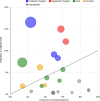Mechanism and Catalytic Site Atlas (M-CSA): a database of enzyme reaction mechanisms and active sites
- PMID: 29106569
- PMCID: PMC5753290
- DOI: 10.1093/nar/gkx1012
Mechanism and Catalytic Site Atlas (M-CSA): a database of enzyme reaction mechanisms and active sites
Abstract
M-CSA (Mechanism and Catalytic Site Atlas) is a database of enzyme active sites and reaction mechanisms that can be accessed at www.ebi.ac.uk/thornton-srv/m-csa. Our objectives with M-CSA are to provide an open data resource for the community to browse known enzyme reaction mechanisms and catalytic sites, and to use the dataset to understand enzyme function and evolution. M-CSA results from the merging of two existing databases, MACiE (Mechanism, Annotation and Classification in Enzymes), a database of enzyme mechanisms, and CSA (Catalytic Site Atlas), a database of catalytic sites of enzymes. We are releasing M-CSA as a new website and underlying database architecture. At the moment, M-CSA contains 961 entries, 423 of these with detailed mechanism information, and 538 with information on the catalytic site residues only. In total, these cover 81% (195/241) of third level EC numbers with a PDB structure, and 30% (840/2793) of fourth level EC numbers with a PDB structure, out of 6028 in total. By searching for close homologues, we are able to extend M-CSA coverage of PDB and UniProtKB to 51 993 structures and to over five million sequences, respectively, of which about 40% and 30% have a conserved active site.
© The Author(s) 2017. Published by Oxford University Press on behalf of Nucleic Acids Research.
Figures


References
-
- Kirby A.J. The lysozyme mechanism sorted — after 50 years. Nat. Struct. Mol. Biol. 2001; 8:737–739. - PubMed
Publication types
MeSH terms
Substances
Grants and funding
LinkOut - more resources
Full Text Sources
Other Literature Sources

